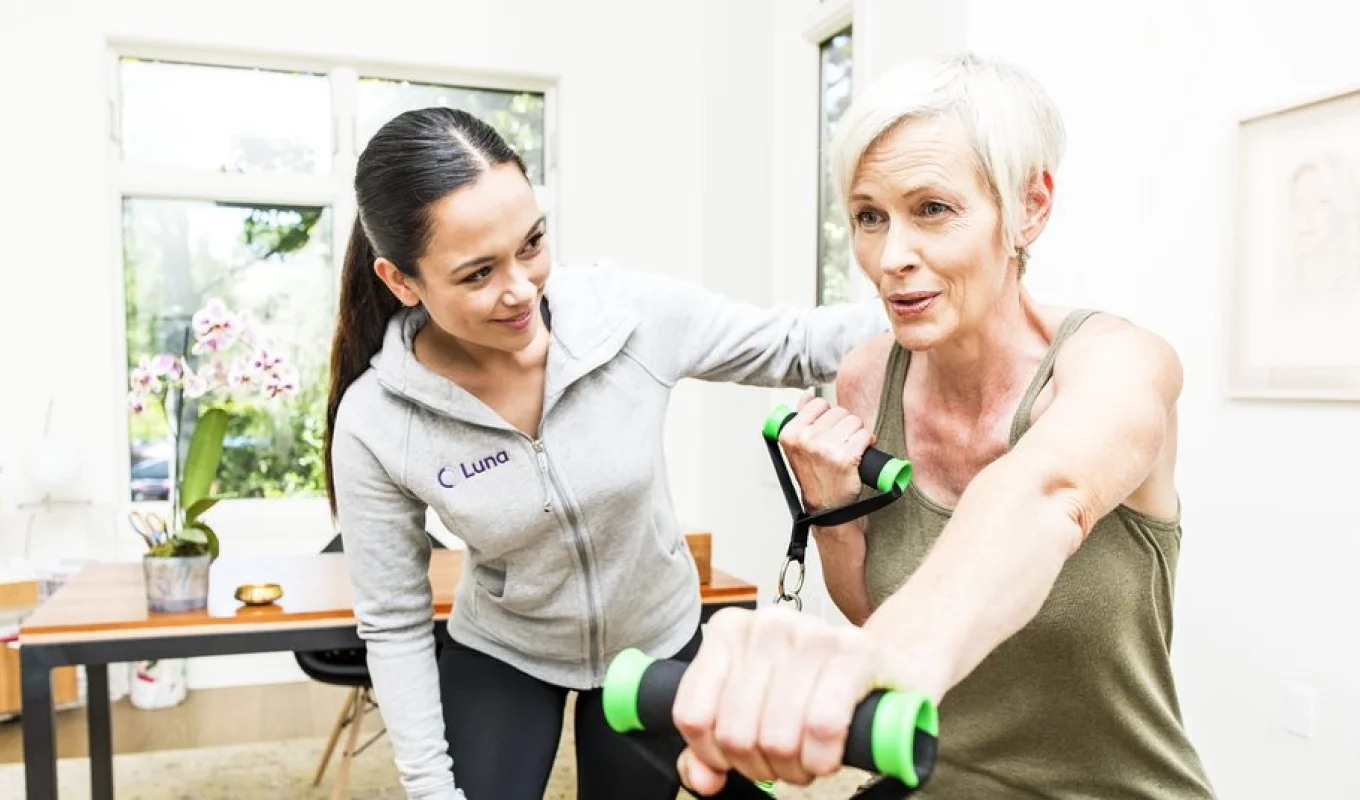Have you ever wondered what equipment physical therapists use to get you back on your feet (or strengthen your core, improve balance, etc.)? While some tools are exclusive to clinical settings, many can be used as effectively at home to enhance your physical
therapy (PT) program. Whether recovering from an injury, managing a chronic condition, or simply looking to improve your
physical health, having the right equipment at home can make a significant difference. This list will explore some of the most popular pieces of PT equipment and how they can benefit your recovery.
1. Resistance Bands
Resistance bands, also known as workout or exercise bands, are large elastic bands used to strengthen muscles and improve flexibility. They come in different types, sizes, shapes, and colors that indicate how much resistance they provide. They can also
have handles and be looped or non-looped. The contracting motion builds muscle strength as the user pulls against the band. They can also benefit people with limited mobility because they can do many resistance band exercises while seated.

2. Foam Rollers
Foam rollers are cylindrical tools made of compressed foam. They are used to relieve tension and stretch out sore muscles. They are also used for self-myofascial release (SMR), a type of soothing self-massage that involves applying gentle pressure to
the body’s fascial tissues. Foam rollers are especially useful for athletes and individuals dealing with muscle tightness.

3. Exercise Balls
Exercise balls, also known as stability balls, Swiss balls, physio balls, or fit balls, are large, air-filled, soft elastic balls used to enhance balance, coordination, and core strength. The ball’s unstable surface forces a deep activation of the core muscles, creating a unique and highly effective way to improve posture, balance, and stability throughout the body. Exercise balls can also be used for self-massage and to help
improve proprioception (body awareness).

4. Hand Therapy Equipment
Effective hand and wrist use requires a great deal of fine motor skills. Physical therapists utilize various tools to replicate the intricate tasks your hands are responsible for. These tools include therapy putty, grip strengtheners, and finger exercisers,
each of which helps improve hand strength, dexterity, and coordination. Hand therapy equipment is beneficial for individuals recovering from hand injuries or surgeries.

5. Dumbbells
Dumbbells, also known as hand weights or free weights, are small, handheld weights used in physical therapy and exercise routines to improve strength, endurance, and muscle tone. They come in various sizes and weights, typically ranging from a few pounds
to several dozen pounds, allowing for a wide range of exercises and rehabilitation activities. PTs normally use dumbbells for strength training, rehabilitating injuries, improving range of motion, enhancing balance and coordination, and boosting muscle
endurance.

6. Ankle Weights
When attached to the ankles, ankle weights effectively strengthen the hip, knee, and thigh muscles. They can also improve walking dynamics and knee joint repositioning. Additionally, ankle weights enhance balance in individuals recovering from strokes. These versatile tools can also be attached to the feet or arms for additional strengthening and rehabilitation exercises.

7. Balance Boards
Balance boards, including wobble and rocker boards, are tools designed for standing exercises. Physical therapists use these boards to enhance balance and posture, support rehabilitation, prevent lower body injuries, and strengthen the core. They are
particularly effective in rehabilitating lower leg injuries, such as ankle sprains. Additionally, balance boards are
valuable for preventing sports-related injuries and reducing the risk of falls in people of all ages.

8. Stretching Straps
Stretching straps are versatile tools used in physical therapy to enhance flexibility and assist with various stretches. Typically made from durable materials like nylon or cotton, these straps often feature multiple loops or handles to accommodate different
grip positions and stretching intensities. They help patients achieve deeper stretches, especially in hard-to-reach areas or when flexibility is limited. Stretching straps can increase joint range of motion and prevent injuries related to muscle tightness
and imbalances. They are particularly useful in rehabilitation programs for conditions like tendonitis, muscle strains, and post-surgical recovery, helping to restore function and mobility.

9. Kinesiology Tape
Kinesiology tape, also known as Kinesio Tape (KT), supports and stabilizes muscles and joints without restricting movement. It helps reduce pain, enhance performance, and aid in the recovery of injured areas of the body, such as shin splints. This therapeutic tape is especially beneficial for active individuals and athletes.

10. Knee Braces
Knee braces are supportive devices worn around the knee to provide stability, protection, and pain relief. They come in various designs, including sleeves, wraparounds, hinged braces, and straps, each serving different functions based on the user’s specific
needs. When worn properly, knee braces can also help prevent injuries and aid in recovery from surgeries or other conditions like arthritis.

11. Massage Balls
Massage balls, also known as therapy balls, are similar in size to lacrosse balls. They are compact, firm balls typically made of rubber or plastic. Massage balls can provide deep tissue compression to quickly soothe aches, pains, and muscle fatigue,
especially in hard-to-reach areas like the upper back, shoulders, hips, and feet. They are often used to relieve neck, sciatic nerve, herniated disc, and fibromyalgia pain.

12. Heat and Cold Packs
Heat and cold packs are essential for managing pain and inflammation. Heat packs, also known as hot or warm packs, relax muscles, improve blood flow, and relieve pain. They come in various forms, such as microwavable gel packs, electric heating pads,
and single-use chemical heat packs. On the other hand, cold packs, known as ice or cool packs, reduce swelling and numb pain. These include reusable gel packs, single-use instant cold packs, and ice bags. Both heat and cold packs are typically applied
for 15-20 minutes at a time. Alternating between heat and cold every few hours can be an effective therapy; icing first cools down the injured area and reduces swelling, while heat helps diminish inflammation.

13. Massage Guns
A massage gun, a percussive therapy device, is a handheld, battery-operated tool designed to deliver rapid, concentrated pulses of pressure deep into the muscle tissue. These devices typically feature a motorized, oscillating head that moves back and
forth, providing deep-tissue massage. They are usually portable, rechargeable, and easy to use on various parts of the body. Massage guns are most often used for muscle recovery, pain relief, improving blood flow, increasing range of motion, and as
a stimulating warm-up tool for athletes.

Knowing what equipment physical therapists use is good…
…but using those tools with the professional guidance of a physical therapist is better. An experienced PT will help you avoid injuries and streamline your recovery for even faster, more effective relief. And for the same price as visiting a clinic, you
can enjoy convenient in-home physical therapy services with Luna. Our in-home PT provides:
- Convenience: No need to deal with traffic or parking. Our therapists come to you.
- Personalized Care: Tailored therapy sessions to meet your specific needs.
- Expert Therapists: Board-certified, highly-trained, and vetted physical therapists.
Are you ready to start your journey to recovery with the best physical therapy tools and therapists? Contact Luna and experience the comfort and care of in-home physical
therapy today.








